


We were impressed by Bikaner's beautiful fort palaces and extraordinary havelis. The traditional dancers at the Laxmi Niwas Palace were fabulous.

All of the drives between locations seemed to pass very quickly. We had an excellent driver and usually made one short refreshment stop. The five hour drive between Jaipur and Bikaner was no exception. Soon the predominant mode of goods transport became camel-drawn cart. The lorries look hugely overloaded - fat-bellied tarpaulins stuffed and hanging over the sides and back. Mustard fields soon gave way to a much drier landscape and eventually desert-like conditions with scrub and what looked like thorn trees that the camels eat. Eventually we started to see small round buildings with conical straw roofs which one of our guides later told us are for storing hay, though I was sure I'd seen a bed in one.





In Bikaner we stayed at the beautiful Laxmi Niwas Palace. Built in 1902 it was the principal residence of the Maharaja Ganga Singh. It's architectural style is a combination of Indian and British revivalist Gothic. We had a huge suite (though I believe all the rooms are large), very traditionally furnished in an English style.


The hotel has a wonderful fully enclosed courtyard with fountains where we ate in the evening, and also huge reception rooms, including a huge games room with billiard table and rather too many heads and skins of tigers and deer for my liking.
The red sandstone glows warmly in the late evening or early morning sun and it is a peaceful and very atmospheric place to stay.
We had some of the best curries of our trip here - one Korma chicken and coriander was so good we ordered a second serving!

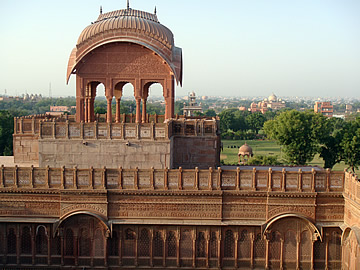

In the evening traditional dances were performed - these were the most impressive performances we saw in India, the main female dancer danced with bowls of fire balanced on her head and, for one dance, on crushed glass and knives. The dances with bowls of fire were so incredible I wondered whether they were designed specifically for tourists but later I asked our guide about them and he said that they were very special traditional dances, not often performed and that we'd been very lucky to see them.

In the video the graceful dancer is amazing, she moves her hips and shoulders making beautiful hand and arm movements, all the while keeping her head perfectly steady and balancing an immense tower of fire bowls. Towards the end she dances while balancing on a metal ring, making it slap on the floor from side to side in time to the music.

Bikaner was founded in 1488 by a Rajput prince Rao Bika, a son of the founder of Jodhpur Rao Jodha. James Tod, a British officer and historian of Bikaner, says that the second part of the name "Bikaner" comes from a Nehra who had title to the land. He allowed establishment of a settlement only if his name was linked with it - hence Bika - ner.




Situated on a major trade route the city prospered and over many centuries the wealthy merchants built their beautifully carved havelis, mostly in the nineteenth and early twentieth centuries.
Our guide took us by tuk-tuk into the narrow streets of the old town - it's very difficult to get a car down into these streets.

The havelis we saw seemed to be in excellent condition, locked and guarded, and one converted to an atmospheric hotel, the Bhanwar Niwas Haveli, which we were able to enter. They are all built in red sandstone and richly carved with delicate stone latticework.



It was late afternoon when we were wandering these streets and the children were returning home from school. Everywhere we went in India the children were fascinated by us (or our cameras!) and wanted to have their photographs taken and then to look at the images on the screen.







Jainism was founded in 500BC as a reaction against the dominance of priests in Hindu society. It rejects the caste system, avoids ritual and believes in reincarnation. Jains are strict vegetarians and revere all forms of life.





The Bhandasar Temple was commissioned by a wealthy merchant in 1468 but he died before it was completed in 1514. It is dedicated to the fifth Jain tirthankar or pathfinder, Sumitnath. Inside the temple is completely covered with colourful carvings and paintings. Legend has it that ghee was used in its construction!
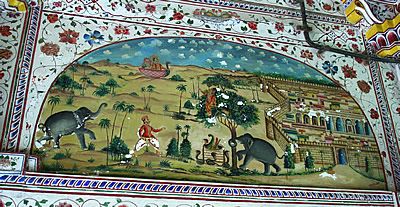





The fort was constructed between 1588 and 1593 by Raja Rai Singh, a general in Akbar's army and the first Raja of Bikaner, ruling for over 40 years from 1571 to 1612.
Many palaces have been added by subsequent Maharajas. It is unusual in that it does not occupy a hilltop position.
Though Bikaner was involved in many battles with the Mughals the fort was never conquered. Its moat is now dry but the wall and bastions are intact.






It's hard to keep track of all the beautiful palaces here within the fort. They have some of the most exquisitely decorated rooms of any we saw in India: wonderful painted doors, gilded ceilings, mirror work and tiles.
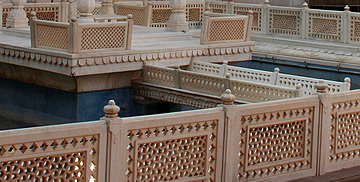



Dutch tiles, particularly Delft tiles, were the height of opulence.


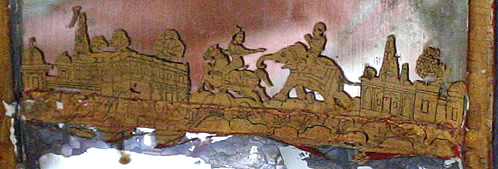

One beautiful room had a Maharaja's throne complete with large manual ceiling fan known as a punkah.
The tiny detail in the paintings is amazing - this Indian art is called miniature painting because of such fine detail, not because they are small - which they generally aren't!



This palace has the most exquisite wall paintings. We had to pay a little baksheesh to see this but it was absolutely worth it.
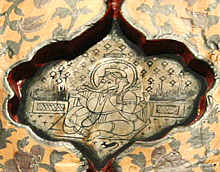











Through these sets of rooms in the Moon Palace we eventually came to the Flower Palace. Though it seemed not to be fully open to visitors we could see some of its beautiful decoration.
The Phool Mahal was built during the reign of Maharaja Gaj Singh (1745-1787). Its walls are covered with paintings of flowers. It has many stained glass windows patterned to look like flowers.



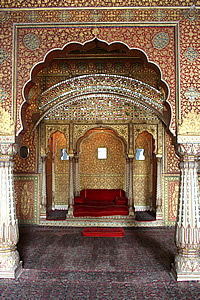

Built by Raj Anup Singh, eldest son of Karan Singh and the tenth ruler of Bikaner from 1669 to 1698.
It has the most beautiful delicately carved white marble courtyard with more amazing latticework..


This lavishly decorated room is a private audience chamber for honoured guests and visitors. The red-cushioned throne is set in a niche studded with mirrors and coloured glass. It is quite dazzling!
The carpet is said to have been made by prisoners in Bikaner jail.
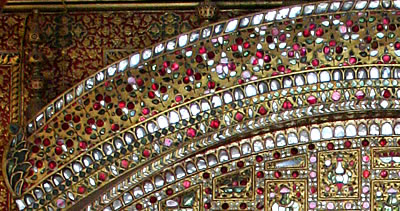



Named for the beautiful fresco paintings of clouds on its walls this is a uniquely decorated room - at least in all the other palaces we saw we didn't see anything else like this.
The clouds are beautifully stylised. In some frescos rain falls. In others red and orange lightning bolts weave like snakes between the clouds.
There is a celebrated painting of Krishna and his consort Radha in the midst of a thunderstorm!


The cavernous Diwan-i-Khas was built by Ganga Singh who ruled from 1898 to 1944. every inch of the red sandstone walls is carved with with foliage, flowers, birds, animals and human figures.


We finally came to the museum, to be met by the incongruous sight of a First World War biplane presented to Ganga Singh by the British Government.
This is a really magnificent fort with an incredible amount of beautiful art and architecture to see - a highly recommended visit.